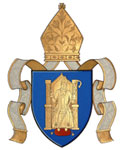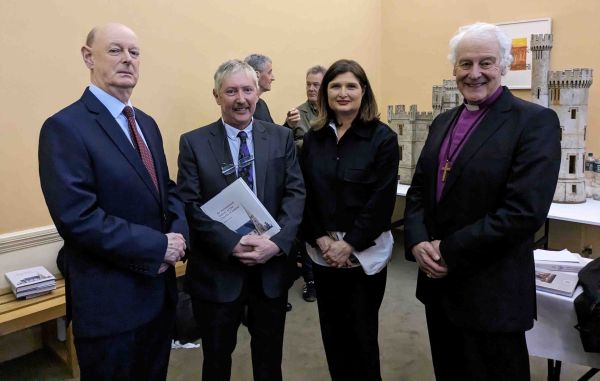 |
 |
News
New study of Church of Ireland architecture launched in Dublin

Attending the launch of 'An Architectural History of the Church of Ireland. Photo by Abbie O'Neill.
“Books like this don’t come around very often as they are a long time in the making,” Dr Sandra O’Connell remarked when launching An Architectural History of the Church of Ireland before a large audience at the Irish Architectural Archive.
The Royal Institute of the Architects of Ireland’s Director of Architecture and Communications noted that a long time, in this case, was “12 years precisely” beginning with “the monumental task of digitising some 9,500 drawings of ecclesiastical buildings.”
Dr Michael O’Neill, the new book’s author, had undertaken this project on behalf of the Representative Church Body Library; the Church of Ireland’s central library and repository for archives. Its culmination, in printed form, was a popular purchase as the spring evening sunshine shone in from Merrion Square.
An Architectural History gives the most definitive account yet published on the built legacy of the churches, houses for clergy, and cathedrals of the Church of Ireland from the medieval period to the present day. This well-illustrated 394-page publication has been generously supported by the General Synod Royalties Fund and follows on from A Visual Window to an Ecclesiastical World, an exhibition of the Church’s architectural drawings also in the same venue, in the summer of 2019.
The contents of the book “combine into a rich, colourful tapestry of ecclesiastical history through which this book weaves like an illuminating golden thread,” Dr O’Connell continued, describing the author’s extensive “detective work” in visiting and exploring contemporary church interiors. What he has rediscovered for his readers spans centuries; many of the Church’s older buildings first formed part of a medieval landscape before being shaped by the austere simplicity of Reformation interiors, and the huge expansion of construction works funded through the Board of First Fruits and the Ecclesiastical Commissioners.
“I would encourage you all to buy and read this rich and wonderful book … and to bring it with you on your Irish travels this summer,” she concluded.
Speaking in response, Archbishop Michael Jackson expressed a challenging question which the book seems to articulate: “How did so few people merit so many buildings?”
Many of the historical shifts which underlay architectural changes, he reflected, were political and unfortunately reflected poorly on how the Church of its day considered, or did not consider, the needs of people living in poverty or indeed visitors.
The failure of “an essentially English Reformation” in Ireland, he noted, “can in part at least, be ascribed to the Church of Ireland being slow, unwilling or uncomprehending about translating everything that might be spoken into the Irish language.”
Later canon law which required that the clergyman “stand in or among the congregation” not only changed the focus of the Church’s approach but had a bearing on its buildings as well: the pulpit, font, reading desk and communion table thus becoming “the staples, the basics of plain religion.”
Archbishop Jackson asked the audience to consider: “Are our churches well positioned for mission?” before adding that mission is “God already in and with the people for whom there is no room in the inn … as well as for those who are already its members.”
Each church building tells a human story, whether it’s a small parish church or cathedral, and these buildings “approach us across the Irish landscape.” The activities of “purposing and re-purposing, innovation and renovation” are required of us in our own day “as we work out what to do with these fascinating buildings pulsating with interest for those who, like the author, are able to read them and teach others to do so.”
Speaking of the light of this study and as Easter 2023 “beckons us all into the light of resurrection life,” Archbishop Jackson concluded: “The church is where people gather and where, in the words of TS Eliot, prayer is valid. It has always used its buildings to do just this. Like others, I trust that it will continue to do so.”
In his words of appreciation, Dr O’Neill thanked Dr Susan Hood, the RCB’s Librarian and Archivist, for “running with the notion of an exhibition” and proposing the book to follow on from it.
“I find church buildings fascinating,” he commented, “not simply recognising the architectural styles but the hints of internal arrangements reflecting changes in churchmanship and worship styles as well as the social and cultural values discernible therein. I more or less grew up reading Brian de Breffney’s Churches and Abbeys of Ireland, Arthur Champneys, HG Leask and Maurice Craig. And later work by Roger Stalley, Eddie McParland and Alistair Rowan. If this book adds to the work they have done, I will be delighted.”
An Architectural History of the Church of Ireland is available from the Church of Ireland’s online bookstore; https://store.ireland.anglican.org �' at £50/€55.